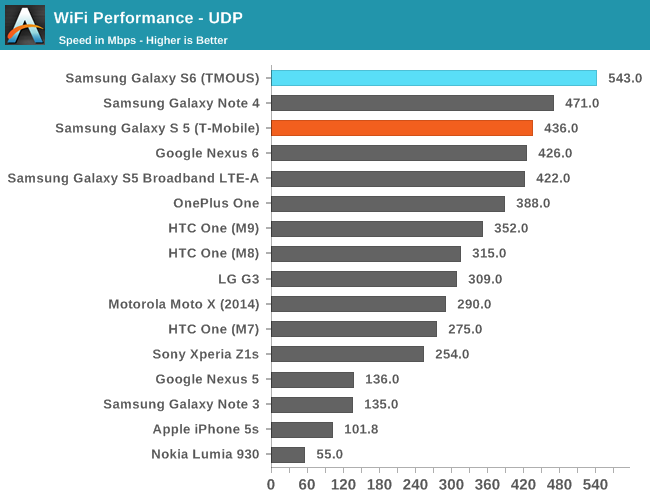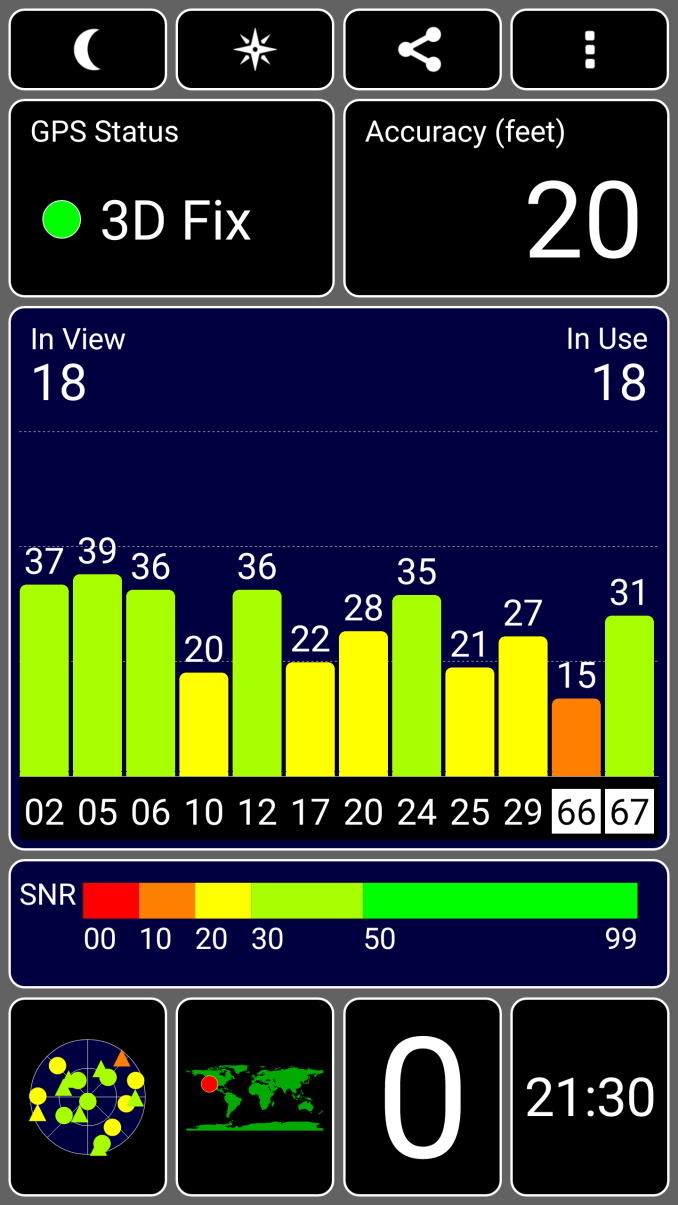The Samsung Galaxy S6 and S6 edge Review
by Joshua Ho on April 17, 2015 9:00 AM EST- Posted in
- Smartphones
- Samsung
- Mobile
- Galaxy S6
- Galaxy S6 Edge
WiFi Performance
As WiFi is still quite important on a smartphone for anyone on a relatively limited data plan, it's also important to test how well a device behaves when using WiFi. In order to do this, we use our standard iperf test to see how fast the device can send UDP packets. In the case of the Galaxy S6, we see that it shares the same BCM4358 WiFi/Bluetooth combo chipset that we first saw in the Galaxy Note 4. As always, in order to ensure maximum possible performance we're using an Asus RT-AC68U router to avoid issues with the router bottlenecking the phone.

As we can see, the Galaxy S6 manages to do better than anything else we've been able to test in recent memory. I'm not sure what's causing the difference in performance when comparing against the Note 4, but it's definitely possible that the antenna configuration has been improved to increase coherence and therefore the performance benefit that comes from MIMO.
GNSS Performance
In most of the Galaxy S6 variants, as there is no Gobi modem that could be used to provide GNSS location services it seems that Samsung has turned to Broadcom to provide satellite location services. In the case of the Galaxy S6, we see a Broadcom BCM4773 location chipset. This includes support for all of the major constellations including GPS, Beidou, and GLONASS in addition to SBAS, which helps to improve accuracy beyond what conventional GPS satellites can provide. To get a good idea for how good this system is I tried testing how long it took for a lock to happen on a clear night with airplane mode on. The Galaxy S6 managed to acquire a lock in 20 seconds which is likely to be a warm lock but a cold lock will likely take a minute without assistance data. After an additional 20 seconds I saw a peak accuracy of 20 feet, so there shouldn't be any notable issues with the GPS system. For the Galaxy S6 CDMA variants it's likely that location will be done using the MDM9x35 Gobi modem rather than the Broadcom solution used in the GSM Galaxy S6.
Misc
For the Galaxy S6, Samsung has fundamentally uprooted how they traditionally design their phones, and in the case of the entire radio architecture this is especially true. Instead of the standard Qualcomm modem, we see that Samsung has moved to the Shannon 333 GSM/LTE modem for the Galaxy S6 GSM variants. Given that this is likely to be the same modem that is in the Note 4 LTE-A it’s likely that this modem will ship as category 6, while we have reason to believe it's ultimately capable of UE category 9. However, whether the RF front-end is capable of handling 3x carrier aggregation of up to 450 Mbps on the downlink is a different question and is likely to be one that we won’t know the answer to unless support is added in an OTA update.
The transceiver, envelope tracker, antenna tuner, and most of the components that would traditionally be Qualcomm parts in a Snapdragon-equipped phone have also been replaced with Samsung Shannon components based upon the Chipworks teardown. In general though, I didn’t notice any issues with this choice of RF components although judging by the use of Qualcomm modems in the CDMA variants it’s likely that such a move was necessary in order to ensure good RF performance on CDMA networks but not GSM networks due to Qualcomm’s experience with CDMA2000. It's likely that anyone that has had previous experience with the CDMA Galaxy Nexus would be able to attest to this.
Unlike some other variants, we’ve noticed that the Galaxy S6 T-Mobile variant uses an Audience eS804 voice processor to enable hot word detection and S-Voice launching and is likely also active in phone calls and in any other scenario where noise cancellation and voice processing would be beneficial. The T-Mobile variant that we received also uses an NXP PN547 NFC module rather than a Samsung NFC module, but we did confirm that there is an ST-M digitizer used for the touchscreen and a Cypress CapSense PSoC for the capacitive keys.
Although I still don’t have the equipment to test speakers properly, subjectively the audio quality of the Galaxy S6’s single downward-firing speaker is good. The volume gets high enough that I never really used it on maximum volume for videos, but it’s still annoying to have to cup my hand to ensure that sound is going towards my face rather than traveling away. Overall the M9 still has much better speakers for a good media experience, but there’s nothing wrong with the speaker on the Galaxy S6 for casual use. I definitely found myself using it less than the front-facing speakers on the M9 though.











306 Comments
View All Comments
h3ck - Friday, May 8, 2015 - link
Because even though media, books, music and other content is cloud based and easy to access, applications are getting increasingly larger and you still want to have space for local content in general. I went with the 64GB myself, but I also use a Dash Micro. If you don't know what that is, it's amazing > http://www.amazon.com/Dash-Micro-MicroSD-Android-U...elchepe - Saturday, May 23, 2015 - link
I don't know what world you're living in, but most people take cheap loads of pictures and videos these days. Considering the megapixel count on the S6 and other flagship, expandable memory certainly becomes a necessity. There are plenty of people who know the woes of being unable to update their iPhones because there's not enough space available.deputc26 - Friday, April 17, 2015 - link
I would like to see an APL vs. Brightness graph for maximum manual brightness. Using 100% APL unjustifiably biases the test against AMOLED screens. 60-80% APL would correspond much better to real world scenarios.Brett Howse - Saturday, April 18, 2015 - link
Check the display page again.deputc26 - Saturday, April 18, 2015 - link
"Manual" brightness, not automatic. I checked the display page again and was disappointed.melgross - Saturday, April 18, 2015 - link
The problem amoled has, is if brightness remains too high for too long, the display will burn out after a time. The real max brightness is around 350nits, the same as before. In fact, Samsung is taking a big chance with the max brightness here. I predict that we'll be seeing display life significantly shortened for a number of people who spend a lot of time outdoors with their phones.The life of all LEDs is directly dependent on their temperature. Amoled needs low temps to work, unlike metal based LEDs, used for LCD screen back lights. Their innefficiency means that a lot of power is required for maximum brightness, which leads to overheating. That's why manual brightness on these is the same its been for the last three generations.
Brett Howse - Saturday, April 18, 2015 - link
@deptuc26: So you are concerned about 100% APL being biased against AMOLED but want to see the manual brightness where the scores are lower? I'm confused. You seem to contradict yourself there.melgross - Saturday, April 18, 2015 - link
No, not at all. I'm pointing out that while Samsung has a new brightness setting for outside, you can't use it for regular use. That because using it more than occasionally will damage the display. This is like redlining a car engine. You can do it, but don't do it too often.deputc26 - Saturday, April 18, 2015 - link
Values for both Manual brightness and automatic brightness are given at 100% APL in charts in the review. This is unrealistic, no one walks around with a pure white screen. The review partially makes up for this error by including a "APL vs brightness" graph for automatic brightness. It does not include such a graph for manual brightness leaving the attentive reader wondering what the brightness would be at a realistic APL and leaving the inattentive reader with a false impression.Uplink10 - Saturday, April 18, 2015 - link
Because then people would not buy 64GB or 128GB phones which are very overpriced. They would just buy 32GB/16GB phone and additional MicroSD card. Why? Because of greed.